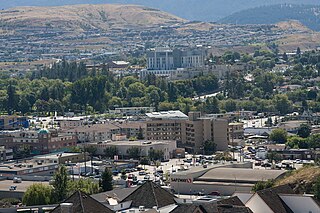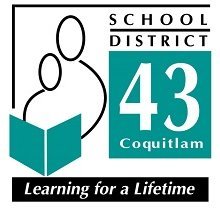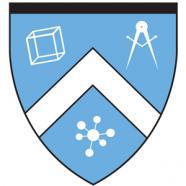See also
| | This British Columbia school-related article is a stub. You can help Wikipedia by expanding it. |
| School District 60 Peace River North | |
|---|---|
| Location | |
Fort St. John Fort St. John, Buick Creek, Hudson's Hope, Prespatou, Taylor, Wonowon in Northeast Canada | |
| District information | |
| Superintendent | Dr Stephen Petrucci |
| Schools | 22 |
| Budget | CA$70 million |
| Students and staff | |
| Students | 6000 |
| Other information | |
| Website | www |
School District 60 Peace River North is a school district in northeastern British Columbia adjacent to the Alberta border. Its board office is in Fort St. John which is also where the majority of the schools are located. It also serves the outlying communities of Taylor, Prespatou, Hudson's Hope, Buick Creek and Wonowon.
School District 60 was the first district in British Columbia to institute a laptop computer program on a large scale (grade 6 and 7). Currently the program provides an iPad to each student in grade 6. SD60 is well known for partnerships with community, industry, post-secondary, neighbouring districts, and businesses.

Education in Canada is for the most part provided publicly, funded and overseen by federal, provincial, and local governments. Education is within provincial jurisdiction and the curriculum is overseen by the province. Education in Canada is generally divided into primary education, followed by secondary education and post-secondary. Education in both English and French is available in most places across Canada. Canada has a large number of universities, almost all of which are publicly funded. Established in 1663, Université Laval is the oldest post-secondary institution in Canada. The largest university is the University of Toronto with over 85,000 students. Four universities are regularly ranked among the top 100 world-wide, namely University of Toronto, University of British Columbia, McGill University, and McMaster University, with a total of 18 universities ranked in the top 500 worldwide.

Maple Ridge is a city in British Columbia, Canada. It is located in the northeastern section of Greater Vancouver between the Fraser River and the Golden Ears, which is a group of mountain summits which are the southernmost of the Garibaldi Ranges of the Coast Mountains. Maple Ridge's population in 2021 was 90,990. Its downtown core area was once known as Haney.

Vernon is a city in the Okanagan region of the Southern Interior of British Columbia, Canada. It is 440 km (270 mi) northeast of Vancouver. Named after Forbes George Vernon, a former MLA of British Columbia who helped establish the Coldstream Ranch in nearby Coldstream, the City of Vernon was incorporated on 30 December 1892. The City of Vernon has a population of 40,000 (2013), while its metropolitan region, Greater Vernon, had a population of 58,584 as of the 2011 Canadian census. With this population, Vernon is the largest city in the North Okanagan Regional District. A resident of Vernon is called a "Vernonite".

Salmon Arm is a city in the Columbia Shuswap Regional District of the Southern Interior of the Canadian province of British Columbia that has a population of 17,706 (2016). Salmon Arm was incorporated as a municipal district on May 15, 1905. The city of Salmon Arm separated from the district in 1912, but was downgraded to a village in 1958. In 1970, the city of Salmon Arm once again reunited with the District Municipality. Salmon Arm once again became a city in 2005, and is now the location of the head offices of the Columbia-Shuswap Regional District. It is a tourist town in the summer, with many beaches, camping facilities and house boat rentals. Salmon Arm is home to the longest wooden freshwater wharf in North America.

Hope is a district municipality at the confluence of the Fraser and Coquihalla rivers in the province of British Columbia, Canada. Hope is at the eastern end of both the Fraser Valley and the Lower Mainland region, and is at the southern end of the Fraser Canyon. To the east, over the Cascade Mountains, is the Interior region, beginning with the Similkameen Country on the farther side of the Allison Pass in Manning Park. Located 154 kilometres (96 mi) east of Vancouver, Hope is at the southern terminus of the Coquihalla Highway and the western terminus of the Crowsnest Highway, locally known as the Hope-Princeton, where they merge with the Trans-Canada Highway. Hope is at the eastern terminus of Highway 7. As it lies at the eastern end of the Fraser Valley in the windward Cascade foothills, the town gets very high amounts of rain and cloud cover – particularly throughout the autumn and winter.

School District No. 43 (Coquitlam) or SD43 is one of the sixty school districts in British Columbia. The district is the third-largest in British Columbia with 45 elementary schools, 14 middle schools, and 11 secondary schools. School District No. 43 (Coquitlam) serves the Tri-Cities, including the cities of Coquitlam, Port Coquitlam, Port Moody, and the villages of Anmore and Belcarra. The school district covers an area of 120 square kilometres and serves a total combined population of 210,390 residents. It has over 4,000 full-time and part-time employees. It has one of the highest graduation rates in the province, with 91.9% of students graduating in the 2013/14 school year.
The Cowichan Valley School District, is located in the Cowichan Valley on Vancouver Island, British Columbia, Canada. It consists of numerous elementary, middle, Secondary schools, and alternative schools for programs like adult education.

The Vancouver School Board (VSB), officially the Board of Education of School District No. 39 (Vancouver), is a school district based in Vancouver, British Columbia, Canada. A board of nine elected trustees governs this school district that serves the city of Vancouver and the University Endowment Lands.

Barriere is a district municipality in central British Columbia, Canada, located 66 km (41 mi) north of the larger city of Kamloops on Highway 5. It is situated at the confluence of the Barrière River and North Thompson Rivers in the Central North Thompson Valley.
School District 35 Langley is a school district in British Columbia. This includes the municipalities of Langley Township and Langley City.
School District 27 Cariboo-Chilcotin is a school district in central British Columbia. It covers a large geographic area in the Chilcotin and Cariboo districts, from 100 Mile House in the south to Williams Lake in the north.
School District 53 Okanagan Similkameen is a school district that serves fragments of the southern Okanagan and lower Similkameen regions, which include Cawston, Hedley, Keremeos, Okanagan Falls, Oliver, and Osoyoos, totaling to six communities in the district, all of which are in British Columbia, Canada. Its main "maintenance department" office is held in Oliver, consisting of ten schools, five of which are elementary, three are high or secondary schools, while two are alternative schools. This district's superintendent is Marcus Toneatto, while 2,665 students attend schools in it; there are 480 employees for the Okanagan Simlkammen school district. Their motto is "Learning Today for Living Tomorrow", and all places within the district are towns or villages.

School District 68 Nanaimo-Ladysmith is a school district on central Vancouver Island in British Columbia. This includes the major centres of Nanaimo and Ladysmith. It is also covers the surrounding communities and the adjacent northern Gulf Islands.
School District 74 Gold Trail is a school district in British Columbia. It covers the area of the northern Fraser Canyon along Highway 1. This district includes the communities of Ashcroft, Clinton, Lytton, Lillooet and Cache Creek and Seaton Portage BC. It is notable for having a high percentage of students with self identified aboriginal ancestry, currently standing at an overall average of 60%. The school district is known for supporting innovative programs such as the Connected Classroom project and the Summit Project. The district is also known for higher than average success rates for both aboriginal and non aboriginal students, and an increasing profile provincially for new models of shared service efficiency between districts through Sr. Staff positions. The district is also known for innovation in governance at the board level by supporting a co-chair model for both the Board of Education and the district's First People's Education Council. The Board of Education has many members engaged in provincial leadership through the British Columbia School Trustees Association and the Thompson Okanagan Branch Association. The district works with nineteen First Nations Bands, more than any other district in British Columbia.
School District 92 Nisga'a is a school district in British Columbia, Canada. Situated in the Nass River valley it covers the First Nations area of the Nisga'a people north of Terrace. This includes the communities of Gitlaxt'aamiks, Gitwinksihlkw, Laxgalts'ap, Gingolx, and the surrounding settlements.

The Columbia Secondary Schoolfor Math, Science, & Engineering is a selective public, sixth- through twelfth-grade school that opened in 2007. A partnership between the New York City Department of Education, the community, and Columbia University, CSS serves students who have an interest in a program focusing on STEM fields.

Education in and around the neighborhood of Harlem, in Manhattan, New York City, is provided in schools and institutions of higher education, both public and private. For many decades, Harlem has had a lower quality of public education than wealthier sections of the city. It is mostly lower-income.

The District of Columbia Public Charter School Board is the regulatory authority and sole authorizer of all public charter schools in Washington, D.C. It provides oversight to 69 independently-run nonprofits and 135 public charter schools which educate more than 45,000 students living in every ward of the city. The board is tasked with approving, monitoring, and evaluating schools, creating policies and conditions to empower educators to do their best work, and actively engaging families, schools, and communities to inform decision-making.
Education in British Columbia comprises public and private primary and secondary schools throughout the province. Like most other provinces in Canada, education is compulsory from ages 6–16, although the vast majority of students remain in school until they graduate from high school at the age of 18. In 2020, 86% of students in British Columbia graduated from high school within six years of entering grade 8. It is also common for children to attend kindergarten at the age of 5, it is increasingly common for even younger children to attend pre-school or early learning programs before their formal school age years.